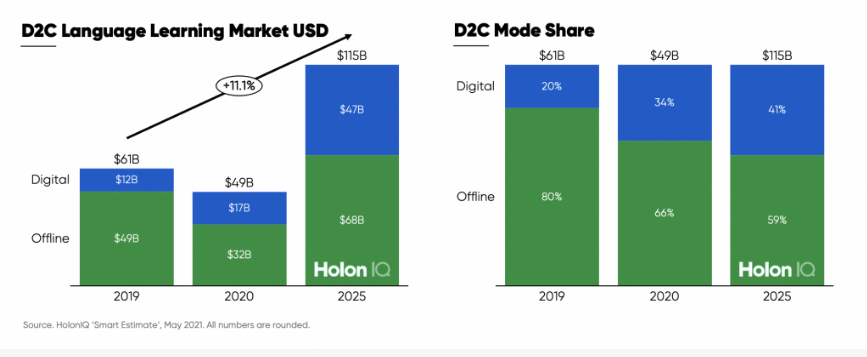Global Appetite for Digital Language Learning Tools Is Surging

The language learning market is undergoing a massive digital transformation as mobile tools designed to teach students those skills have soared in popularity during the COVID era, according to a recent analysis.
That trend could have big implications for the global K-12 marketplace, and the millions of students around the world learning English and other languages, as digital language learning resources are expected to continue evolving rapidly — developing more sophisticated behavioral learning functions and leveraging artificial intelligence.
Mobile language-learning programs and apps will also serve as the primary growth driver in a market historically dominated by offline — in-person or classroom-based — offerings, according to the new research.
HolonIQ, a global research and intelligence firm, estimates the overall market for language learning tools will nearly double in size by 2025 to $115 billion. By then, digital learning language offerings are expected to account for about $47 billion of the market or 41 percent, up from a 20 percent share in 2019 (See graphic below).
“Through the depths of the pandemic we saw digital language learning just absolutely surge,” said Patrick Brothers, the co-CEO and co-founder of HolonIQ, said in an interview. “If you’re running a language learning organization, it’s safe to say, like most people in education nowadays, you’re thinking much more about digital.”
Most people learning a new language are adults, Brothers said, but millions of K-12 students around the world attending international schools are required to study a second language, in many cases English. Many others are voluntarily learning English even if they’re not in international schools.
Brothers said the uptick in adoption of digital language-learning tools means more students attending international schools will be studying a foreign tongue in the future through an app, instead of just relying on face-to-face classroom instruction or a private tutor. K-12 students will be more likely to pursue their required language studies outside of the classroom via a mobile offering, he said, and in many cases, schools overseas will also start incorporating more digital language learning into their curriculum.
Some huge overseas markets — such as India, China, and Latin America — appear likely to jump on board with the growing use of mobile language-learning tools for K-12 students, he said, noting that in China parents can sometimes spend more for outside tutors to teach their children English than the cost of private school.
“In many of those markets English is a tool parents are willing to invest in,” Brothers said.
In-Person Lessons Expected to Rebound
In 2020 — a year in which students around the world were predominantly attending classes remotely — the market for digital language learning tools increased from $12 billion in 2019 to $17 billion.
Meanwhile, the market for offline language learning administered in-person by a teacher or a tutor was valued at $29 billion 2020, down from $45 billion in 2019.
Brothers said that decline was mostly due to Covid-19 travel restrictions and lockdowns.
But HolonIQ estimates the long-term demand for campus-based or peer-to-peer language learning will rebound as COVID conditions improve globally. And demand for offline language learning could exceed 2019 levels by 2021, according to the analysis, which predicts that segment of the market could bring in $64 billion in revenue by 2025.
Currently, most offline language learners are spending an average of $1,000 to $3,000 a year. However, Brothers said the average annual spend for digital language learning ranges from $50 to $70 a year, essentially serving as an affordable alternative to in-person lessons or as an “on-ramp” for when families have the money to invest in offline language learning.
Bigger and Stronger
Not only are the digital language learning offerings a generally cheaper alternative, Brothers said, but they’re improving in quality.
“It’s one area of learning where we’ve really seen the proper promise of personalized and adaptive learning,” he said, noting that AI and voice recognition will play an increasingly larger role in language-learning apps in the future. “You can tell when you use one of these language-learning apps that it’s really clever in how it’s trying to keep you motivated and learning the right thing.”
And the uptick of digital language-learning usage will undoubtedly spawn new companies into the market, as “we’ve seen in the last couple of weeks and months more and more smaller digital player language learners are getting funding and growing,” Brothers said.
But the already dominant players — such as Duolingo — are expected to “get bigger and grow stronger,” he said.
Image by Getty
See also:

